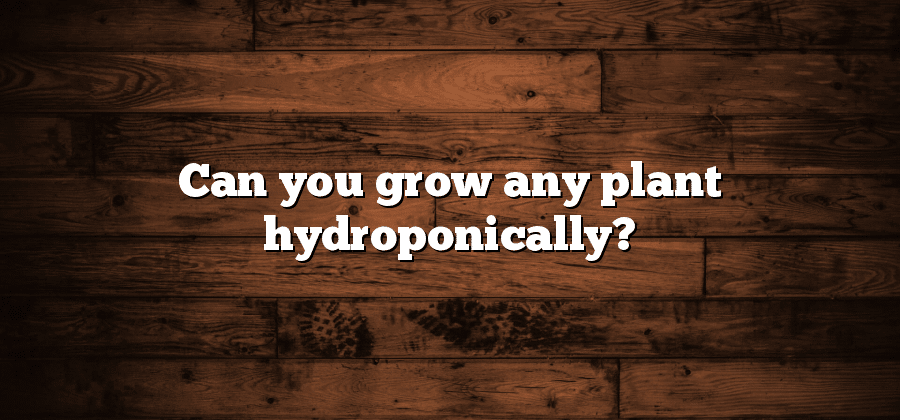Plants Suitable for Hydroponics
One of the main advantages of hydroponic cultivation is that it enables the growth of a wide variety of plants. From leafy greens like lettuce and spinach to herbs such as basil and cilantro, hydroponics provides a suitable environment for these plants to thrive. Additionally, fruits like tomatoes, strawberries, and cucumbers can also be successfully grown hydroponically. This versatility makes hydroponics an appealing option for both commercial farmers and home gardeners.
Another benefit of hydroponics is that it allows for year-round cultivation regardless of the local climate or season. This means that plants can be grown in any location, whether it’s a basement, a greenhouse, or an urban apartment. Furthermore, hydroponic systems eliminate the need for soil, making it possible to grow plants in areas with poor soil quality or limited space. The controlled environment of hydroponics also enables better management of pests and diseases, leading to healthier and more productive plants.
Benefits of Hydroponic Cultivation
Hydroponic cultivation offers numerous benefits that make it a popular choice among growers. One major advantage is the ability to maximize crop yields in a limited space. With traditional soil-based farming, plants need ample space for root growth and nutrient absorption. In a hydroponic system, however, plants receive nutrients directly to their roots, allowing them to grow closer together and utilize space more efficiently. This means that hydroponic growers can produce a higher volume of crops in a smaller area, making it a particularly attractive option for urban farming or areas with limited land availability.
Additionally, hydroponics provides growers with precise control over the growing environment, resulting in healthier and more robust plants. By carefully monitoring and adjusting factors such as water temperature, pH levels, and nutrient concentrations, growers can create optimal conditions for plant growth. This controlled environment minimizes the risk of pests and diseases, allowing for the production of high-quality, consistent crops year-round. The ability to manipulate the growing environment also enables growers to experiment with different nutrient solutions and growing techniques, ultimately leading to a better understanding of plant nutrition and improved cultivation methods.
Choosing the Right Hydroponic System
There are several factors to consider when selecting the right hydroponic system for your cultivation needs. Firstly, take into account the space you have available for your hydroponic setup. If you have limited space, a smaller system such as a nutrient film technique (NFT) or a deep water culture (DWC) system might be more suitable. These systems are compact and can be easily set up in small spaces. On the other hand, if you have ample space, you can opt for larger systems like the ebb and flow or the aeroponics system, which can accommodate more plants.
Another important factor to consider is the level of control you desire over your hydroponic system. For growers who prefer a hands-on approach, a recirculating system, such as a drip or an aeroponics system, would be a good choice. These systems allow for greater control over the nutrient levels and water flow, giving growers the ability to fine-tune the growing conditions for optimal plant growth. Conversely, if you prefer a more automated system that requires less monitoring and maintenance, a non-recirculating system like the nutrient film technique (NFT) or the deep water culture (DWC) system might be a better fit. These systems have a constant flow of nutrient-rich water, eliminating the need for regular nutrient monitoring and adjustment.
Essential Nutrients for Hydroponic Plants
One of the most crucial factors for successful hydroponic cultivation is providing the essential nutrients that plants need to grow and thrive. Unlike traditional soil-based gardening, where nutrients are naturally present in the soil, hydroponics relies on a nutrient solution that is delivered directly to the plants. These essential nutrients are divided into two categories: macronutrients and micronutrients. Macronutrients, such as nitrogen, phosphorus, and potassium, are required in larger quantities, while micronutrients, including iron, manganese, and zinc, are needed in smaller amounts.
Ensuring that the nutrient solution is properly balanced and contains all the necessary macronutrients and micronutrients is vital for the overall health and productivity of hydroponic plants. Many commercially available nutrient solutions are formulated specifically for hydroponic systems and contain the ideal ratios of essential nutrients for optimal plant growth. It is important to regularly monitor the nutrient levels in the solution and adjust accordingly to prevent deficiencies or excesses that can negatively impact plant development. By providing the right mix of nutrients, hydroponic cultivators can promote vigorous growth, maximize yields, and cultivate healthier, more resilient plants.
Optimal pH Levels for Hydroponic Cultivation
Hydroponic cultivation involves growing plants in a nutrient-rich solution instead of traditional soil. One crucial factor to consider when practicing hydroponics is maintaining optimal pH levels. pH refers to the acidity or alkalinity of a substance, and it plays a significant role in plant growth and nutrient absorption. Different plants have varying pH preferences, so it is essential to understand and provide the appropriate pH levels for successful hydroponic cultivation.
For most hydroponic plants, the optimal pH range is between 5.5 and 6.5. Within this range, plants can absorb essential nutrients effectively, ensuring healthy growth and development. pH levels above or below this range can lead to nutrient deficiencies or toxicities, impairing the plants’ ability to thrive. Maintaining the correct pH levels in hydroponic systems is typically achieved by regularly monitoring the solution’s acidity and adjusting it using pH buffering or balancing products. By carefully managing pH, hydroponic growers can create an environment that enhances nutrient availability and promotes optimal plant growth.






